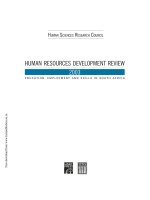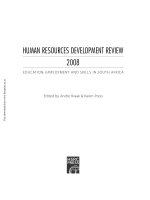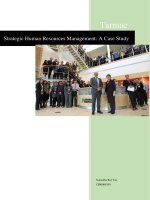Dessler ch 17 managing global human resources
Bạn đang xem bản rút gọn của tài liệu. Xem và tải ngay bản đầy đủ của tài liệu tại đây (325.46 KB, 30 trang )
Gary Dessler
tenth edition
Chapter 17
Part 5 Employee Relations
Managing Global Human Resources
© 2005 Prentice Hall Inc.
All rights reserved.
PowerPoint Presentation by Charlie Cook
The University of West Alabama
After studying this chapter,
you should be able to:
1.
List the HR challenges of international business.
2.
Illustrate how intercountry differences affect HRM.
3.
Discuss the global differences and similarities in
HR practices.
4.
Explain five ways to improve international
assignments through selection.
5.
Discuss how to train and maintain international
employees.
© 2005 Prentice Hall Inc. All rights reserved.
17–2
17–2
The Management Challenges
of International Business
Coordinating market, product, and production
plans on a worldwide basis
Creating organization structures capable of
balancing centralized home-office control with
adequate local autonomy.
Extending its HR policies and systems to
service its staffing needs abroad:
© 2005 Prentice Hall Inc. All rights reserved.
17–3
The HR Challenges of
International Business
Deployment
– Easily getting the right skills to where we need them,
regardless of geographic location.
Knowledge and innovation dissemination
– Spreading state-of-the-art knowledge and practices
throughout the organization regardless of where they
originate.
Identifying and developing talent on a global basis
– Identifying can function effectively in a global organization
and developing his or her abilities.
© 2005 Prentice Hall Inc. All rights reserved.
17–4
Global Staffing Issues
Selecting candidates for overseas assignment
Assignment terms and documentation
Relocation processing and vendor management
Immigration processing
Cultural and language orientation and training
Compensation administration and payroll processing
Tax administration
career planning and development
Handling of spouse and dependent matters
© 2005 Prentice Hall Inc. All rights reserved.
17–5
Intercountry Differences Affecting HRM
Cultural Factors
Economic Systems
Legal and Industrial Relations Factors
The European Union
© 2005 Prentice Hall Inc. All rights reserved.
17–6
Global Differences and Similarities
in HR Practices
Personnel Selection Procedure
The Purpose of the Performance Appraisal
Training and Development Practices
The Use of Pay Incentives
© 2005 Prentice Hall Inc. All rights reserved.
17–7
A Global HR System
Making the global HR system more
acceptable
– Remember that global systems are more accepted
in truly global organizations.
– Investigate pressures to differentiate and
determine their legitimacy.
– Try to work within the context of a strong
corporate culture.
© 2005 Prentice Hall Inc. All rights reserved.
17–8
A Global HR System (cont’d)
Developing a more effective global HR
system
– Form global HR networks.
– Remember that it’s more important to standardize
ends and competencies than specific methods.
Implementing the global HR system
– Remember, “You can’t communicate enough.”
– Dedicate adequate resources for the global HR
effort.
© 2005 Prentice Hall Inc. All rights reserved.
17–9
Summary of Best Practices
© 2005 Prentice Hall Inc.
All rights reserved.
Source: Ann Marie Ryan et al., “Designing and Implementing
Global Staffing Systems: Part 2—Best Practices,” Human
Resource Management 42, no. 1 (Spring 2003), p. 93.
17–
10
Table 17–1
Summary of Best Practices
© 2005 Prentice Hall Inc.
All rights reserved.
Source: Ann Marie Ryan et al., “Designing and Implementing Global Staffing Systems:
Part 2—Best Practices,” Human Resource Management 42, no. 1 (Spring 2003), p. 93.
17–
11
Table 17–1 (cont’d)
Staffing the Global Organization
International staffing: Home or local?
– Expatriates (expats): Noncitizens of the
countries in which they are working.
– Home-country nationals: Citizens of the
country in which the multinational company has
its headquarters.
– Third-country nationals: Citizens of a country
other than the parent or the host country.
Offshoring
– Having local employees abroad do jobs that the
firm’s domestic employees previously did inhouse.
© 2005
Prentice Hall Inc.
17–
All rights reserved.
12
Staffing the Global Organization (cont’d)
Offshoring
– Having local employees abroad do jobs that the
firm’s domestic employees previously did inhouse.
Issues in offshoring
– Having an effective supervisory and management
structure in place to manage the workers.
– Screening and required training for the employees
receive the that they require.
– Ensuring that compensation policies and working
conditions are satisfactory.
© 2005 Prentice Hall Inc.
All rights reserved.
17–
13
Values and International Staffing Policy
Ethnocentric
– The notion that home-country attitudes, management style,
knowledge, evaluation criteria, and managers are superior
to anything the host country has to offer.
Polycentric
– A conscious belief that only the host-country managers can
ever really understand the culture and behavior of the hostcountry market.
Geocentric
– The belief that the firm’s whole management staff must be
scoured on a global basis, on the assumption that the best
manager of a specific position anywhere may be in any of
the countries in which the firm operates.
© 2005 Prentice Hall Inc.
All rights reserved.
17–
14
Why Expatriate Assignments Fail
Personality
Personal intentions
Family pressures
Inability of the spouse to adjust
Inability to cope with larger overseas
responsibility.
Lack of cultural skills
© 2005 Prentice Hall Inc.
All rights reserved.
17–
15
Helping Expatriate Assignment Succeed
Providing realistic previews of what to expect
Careful screening
Improved orientation
Cultural and language training
Improved benefits packages
© 2005 Prentice Hall Inc.
All rights reserved.
17–
16
Selecting Expatriate Managers
Adaptability screening
– Assessing the assignee’s (and spouse’s) probable
success in handling the foreign transfer.
– Overseas Assignment Inventory
• A test that identifies the characteristics and attitudes
international assignment candidates should have.
Realistic previews
– The problems to expect in the new job as well as
about the cultural benefits, problems, and
idiosyncrasies of the country.
© 2005 Prentice Hall Inc.
All rights reserved.
17–
17
I. Job Knowledge
and Motivation
Managerial ability
Organizational ability
Imagination
Creativity
Administrative skills
Alertness
Responsibility
Industriousness
Initiative and energy
High motivation
Frankness
Belief in mission and job
Perseverance
II. Relational Skills
Respect
Courtesy and fact
Display of respect
Kindness
Empathy
Non-judgmentalness
Integrity
Confidence
III. Flexibility/Adaptability
Resourcefulness
Ability to deal with stress
Flexibility
Emotional stability
Willingness to change
Tolerance for ambiguity
Adaptability
Independence
Dependability
Political sensitivity
Positive self-image
IV. Extracultural Openness
Variety of outside interests
Interest in foreign cultures
Openness
Knowledge of local language[s]
Outgoingness and extroversion
Overseas experience
© 2005 Prentice Hall Inc.
All rights reserved.
V. Family Situation
Adaptability of spouse
and family
Spouse’s positive opinion
Willingness of spouse to
live abroad
Stable marriage
Five Factors
Important in
International
Assignee
Success,
and Their
Components
Source: Adapted from Arthur Winfred Jr., and Winston Bennett Jr., “The
International Assignee: The Relative Importance of Factors Perceived to
Contribute to Success,” Personnel Psychology 18 (1995), pp. 106–107.
17–
18
Figure 17–1
Orienting and Training for
International Assignment
There is little or no systematic selection and
training for assignments overseas.
Training is needed on:
– The impact of cultural differences on business
outcomes.
– How attitudes (both negative and positive) are
formed and how they influence behavior.
– Factual knowledge about the target country.
– Language and adjustment and adaptation skills.
© 2005 Prentice Hall Inc.
17–
All rights reserved.
19
Trends in Expatriate Training
Rotating assignments that permit overseas managers
to grow professionally.
Management development centers around the world
where executives hone their skills.
Classroom programs provide overseas executives
with educational opportunities similar to stateside
programs.
Continuing, in-country cross-cultural training
Use of returning managers as resources to cultivate
the “global mind-sets” of their home-office staff.
Use of software and the Internet for cross-cultural
training.
© 2005 Prentice Hall Inc.
17–
All rights reserved.
20
Compensating Expatriates
The “Balance Sheet Approach”
– Home-country groups of expenses—income taxes,
housing, goods and services, and discretionary
expenses—are the focus of attention.
– The employer estimates what each of these four
expenses is in the expatriate’s home country, and
what each will be in the host country.
– The employer then pays any differences such as
additional income taxes or housing expenses.
© 2005 Prentice Hall Inc.
All rights reserved.
17–
21
The Balance Sheet Approach
(Assumes Base Salary of $80,000)
© 2005 Prentice Hall Inc.
All rights reserved.
17–
22
Table 17–2
Incentives
Foreign service premiums
– Financial payments over and above regular base
pay, and typically range between 10% and 30%
of base pay.
Hardship allowances
– Payments to compensate expatriates for
exceptionally hard living and working conditions at
certain foreign locations.
Mobility premiums
– Lump-sum payments to reward employees for
moving from one assignment to another.
© 2005 Prentice Hall Inc.
17–
All rights reserved.
23
Appraising Expatriate Managers
Challenges in appraising oversea managers
– Determining who should appraise the manager.
– Deciding on which factors to base the appraisal.
Improving the expatriate appraisal process
– Stipulate the assignment’s difficulty level, and
adapt the performance criteria to the situation.
– Weigh the evaluation more toward the on-site
manager’s appraisal than toward the home-site
manager’s.
– If the home-office manager does the actual
written appraisal, use a former expatriate from
thePrentice
same overseas
© 2005
Hall Inc. location for advice.
17–
All rights reserved.
24
Differences in International Labor Relations
Centralization
Union structure
Content and scope of
bargaining
Employer organization
Grievance handling
Union recognition
Strikes
Union security
Worker participation
© 2005 Prentice Hall Inc.
All rights reserved.
17–
25









